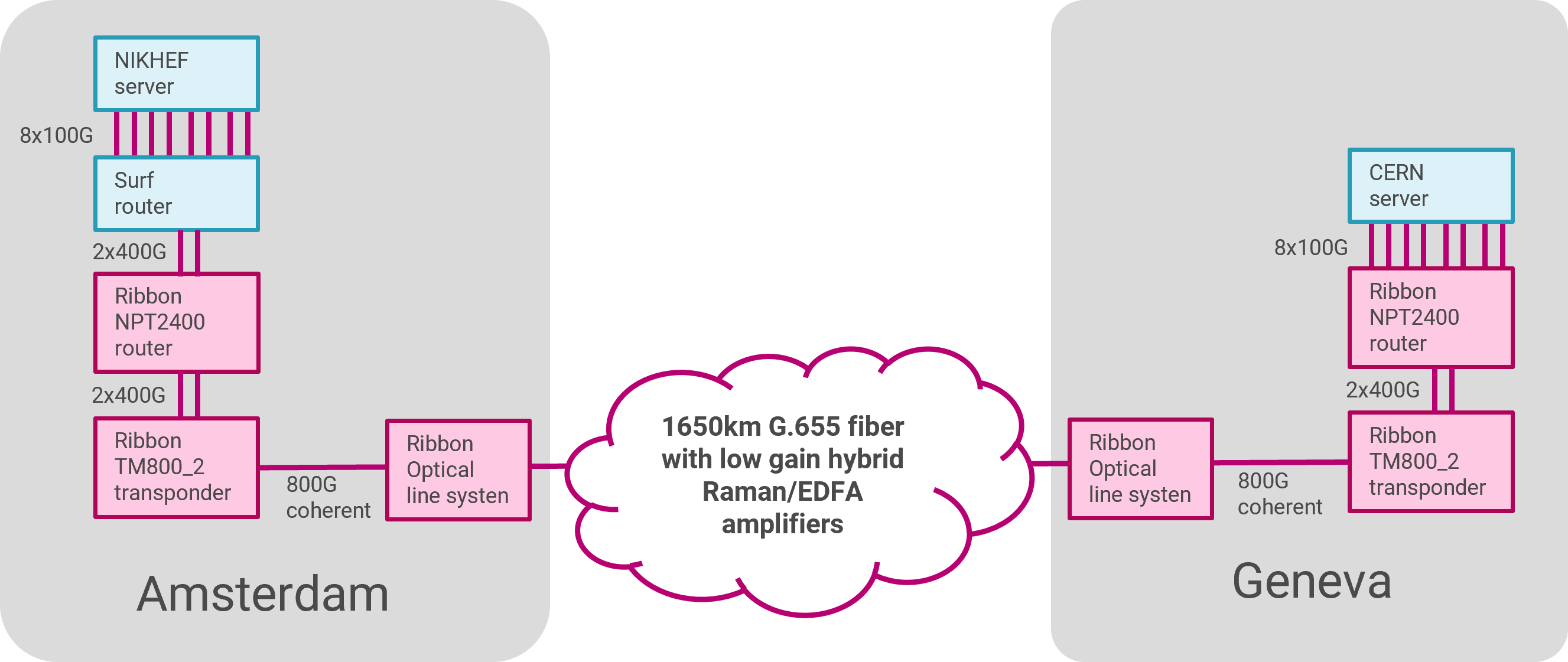How Ribbon Achieved a Single 800G Wavelength over a Brownfield 1,650km Link
Ribbon and SURF recently made headlines by achieving interoperable 2x400GbE transport via a single 800G wavelength across a brownfield 1,650km Amsterdam-Geneva link. In this blog, I dive into the details of this groundbreaking achievement.
Background:
SURF is the collaborative organization for IT in Dutch education and research. More than 100 education and research institutions in the Netherlands work together in the SURF cooperative to fully utilize the opportunities of digitalization. SURF supports over 100 institutions and 1.5 million users, with a vast network spanning 12,000 km of fiber. Since 2016, Ribbon has been the primary provider of optical networking solutions to SURF.
One critical link in SURF's network spans 1,650km, connecting Nikhef, the Dutch National Institute for Subatomic Physics in Amsterdam, with the Large Hadron Collider at CERN in Geneva. This link demands ever-increasing speeds to efficiently transport petabytes of data daily between the two sites for analysis. Specifically, SURF is now preparing for CERN’s upgrade to a High-Luminosity Large Hadron Collider (HL-LHC), which will provide sharper research results and grow the datasets by a factor of 5 to 10.
Currently, the link operates at 400G using 2 x 200G wavelengths, running at 69Gbaud with a 100GHz passband. The goal was to explore whether Ribbon's new high-speed optical transmission technology, capable of running at up to 140Gbaud, could expand the capacity to 800G using a single wavelength.

Challenges:
However, this task posed several challenges. Apart from the link's considerable length and complex infrastructure, including 21 amplifier sites, four ROADMs, and one FOADM, most of the link comprises old G.655 fiber designed for non-coherent 10G wavelengths. This type of fiber introduces problematic non-linear effects when used with modern high-speed coherent transmission.
Solution:
To pave the way for success, Ribbon first upgraded all 21 optical amplifiers to low-gain hybrid Raman/EDFA amplifiers optimized to reduce OSNR in long-haul links. Next, Ribbon modeled the transmission spectrum to select an optimal "sweet spot." Channel 16, situated at the boundary between conventional C-band and extended C-band, was chosen based on channel availability.
With these preparatory steps in place, Ribbon proceeded to turn up the 140Gbaud-capable wavelength to determine achievable transmission speeds. Utilizing the Apollo TM800_2 transponder/muxponder card, which supports two independent high-performance lines, Ribbon achieved remarkable results. This card maximizes the line rate from 400G to 1200G, for any distance and channel width right to the edge of the Shannon Limit. It achieves this based on an exclusive combination of two tunable “knobs”,
- Continuous baud rate from 68Gbaud to 140Gbaud with 1Gbaud granularity,
- Continuous modulation based on probabilistic constellation shaping from 2 to 6 bits/symbol with 0.1 bits/symbol granularity.
By tuning the transceiver to 138Gbaud and widening the flexible grid passband at channel 16 to 175GHz, Ribbon successfully achieved 800G single-wavelength transmission

Demonstration:
In a further demonstration of capability, Ribbon used its NPT 2400 IP router to transport two 400GbE traffic streams over the link and thoroughly tested these with various protocols and interoperability scenarios. These included BGP, ISIS, LDP, SR, EVPN, L2VPN, LAG (LACP), and L2 interop with two other vendors’ routers.
Some of the line cards we used in the demo are shown below. For further inquiries about this trial, please contact me directly at ruediger.zander@rbbn.com.
Learn more about the intelligent middle mile here



